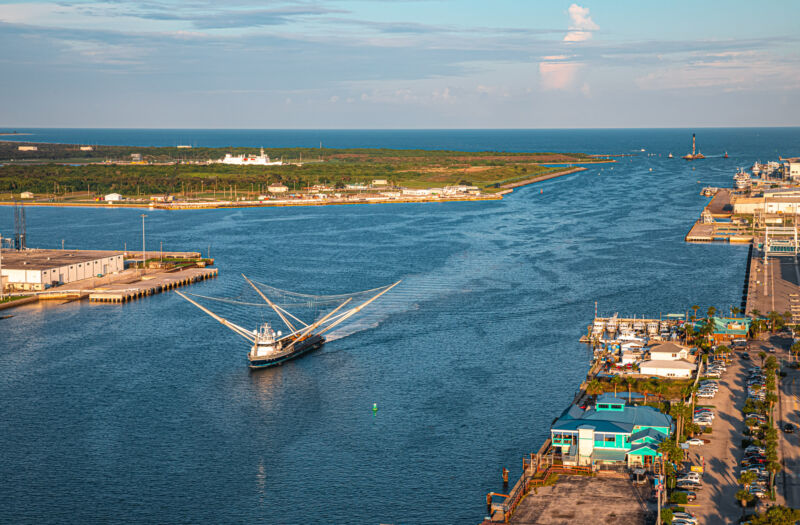
Welcome to Edition 3.40 of the Rocket Report! There were fewer announcements in the realm of launch this week, but that doesn’t mean we lack stories for this report. These include interesting developments on the international front, from the closure of a Russian space tourism country to some fairly serious ethical issues surrounding development of a spaceport in Brazil.
As always, we welcome reader submissions, and if you don’t want to miss an issue, please subscribe using the box below (the form will not appear on AMP-enabled versions of the site). Each report will include information on small-, medium-, and heavy-lift rockets as well as a quick look ahead at the next three launches on the calendar.

ABL Space nabs a huge contract. Under terms of the block-buy agreement between ABL Space Systems and Lockheed, the aerospace giant will purchase “up to” 26 launches through 2026 and as many as 32 additional launches through 2029. If the terms are fulfilled, this would come to 58 launches over the next eight years for ABL Space. Not bad for a company that has yet to launch a rocket.
Working toward a debut launch … “This deal provides significant value to ABL,” Harry O’Hanley, co-founder and chief executive of the company, told Ars. “In terms of our business, the contract provides a consistent source of demand from one of the biggest players in the civil and defense space industries to anchor our manifest through the years ahead.” Before ABL Space can make good on this contract, of course, it has to demonstrate that it can reach orbit. It is currently targeting the third quarter of this year for the first launch of the RS1 vehicle. (submitted by Redngrish)
China planning not one, but two commercial spaceports. The coastal cities of Ningbo and Wenchang are planning construction of new commercial spaceports to meet growing demand for launch in China. The port city of Ningbo in eastern Zhejiang province has committed a total investment of $3 billion to establish a spaceport at Xiangshan, according to SpaceNews. It is to be capable of launching up to 100 missions per year.
Rockets everywhere … Wenchang, China’s coastal launch center developed for large, new-generation Long March 5 and Long March 7 rockets, is also backing the construction of an “integrated and open” launch center to meet commercial launch demand. China currently has inland launch sites at Jiuquan in the northwest, Taiyuan in the north, and Xichang in the southwest of the country as well as the new coastal Wenchang center on the southern island of Hainan. These moves come as several Chinese companies are launching and testing their commercial rockets. (submitted by Ken the Bin)
BWXT receives NASA grant for nuclear reactor work. The Virginia-based nuclear technology company said NASA provided a one-year contract worth $9.4 million to produce fuel kernels, design materials, and manufacturing processes for fuel assemblies. This is part of the technology development needed for an in-space, nuclear-powered rocket engine.
Only a very small start … NASA sees nuclear thermal propulsion as a faster means for humans to reach destinations such as Mars, with lower propellant needs. The grant comes after a recent report, commissioned by NASA, found that if the agency wants to send humans to Mars (and do so repeatedly and in a sustainable way), nuclear space propulsion is on the path. That report said much more significant grants than this, however, would be needed to bring nuclear propulsion online in the 2030s. (submitted by Ken the Bin)
Russian space tourism company closes. A Russian company that planned to send tourists on suborbital space rides from the country’s first private cosmodrome has scrapped the project and will permanently close, The Moscow Times reports. Kosmokurs’ operations will cease due to “insurmountable difficulties” in coordinating with local authorities on the cosmodrome project as well as the company’s “inability to obtain needed regulatory documents from the Defense Ministry” for the design of a suborbital tourist rocket.
Space tourism is hard … CEO Pavel Pushkin founded the private space corporation in 2014 after being inspired by the early success of companies like SpaceX and Blue Origin. Russia’s state space agency, Roscosmos, had previously approved Kosmokurs’ ambitious plan to send tourists to space by 2025 from a private spaceport in the Nizhny Novgorod region. This is a cautionary tale with at least two lessons. First, there just isn’t much of a support network for commercial space in Russia. And second, breaking into space tourism is extraordinarily difficult and costly. (submitted by Ken the Bin)

Falcon 9 rocket drops debris on Washington farm. The atmospheric re-entry and breakup of a SpaceX Falcon 9 rocket upper stage created a fiery display in the skies above the Pacific Northwest in late March, but not all of those shooting stars burned up on the way down. At least one big piece of the rocket—a roughly 1.5-meter-long composite-overwrapped pressure vessel—fell onto private property in southwest Grant County, in the central part of Washington state.
I found your rocket … Kyle Foreman, a spokesman for the sheriff’s office, told GeekWire that the property owner left a message reporting the debris. “The sheriff’s office checked it out on Monday, and SpaceX staff came over on Tuesday and retrieved it,” Foreman said. SpaceX has yet to detail precisely what went wrong with the Falcon 9 rocket’s second stage, such that it failed to de-orbit in a controlled manner over the ocean. Fortunately, no one on the ground was injured. (submitted by Ken the Bin)
Brazilian launch site stirs controversy. The Brazilian government is committed to further developing the Alcântara Launch Center on the country’s north Atlantic coast, near the equator. However, the region is also home to Afro-Brazilian residents of settlements first established by escaped slaves. These settlements are known as Quilombola communities. The Washington Post recently did a deep dive into the controversy, examining how eviction of these communities would affect local residents. The newspaper found that the spaceport expansion could displace nearly 2,100 people from Quilombola communities.
Brazil’s polarizing dilemma … Marcos Pontes, head of the Brazilian Ministry of Science, Technology and Innovation, said there are no plans to relocate families “right now.” And if the time comes to remove people, he predicted, they will go willingly. “They are going to see development coming in, real development,” he said. “All of the resistance, that is going to be gradually disappearing.” This seems unlikely. The clash is the distillation of one of Brazil’s most urgent and polarizing dramas, the publication says. What is more important: developing a vast country with unrealized potential and a lagging economy? Or protecting some of its most vulnerable communities?
SpaceX abandons efforts to “catch” payload fairings. Over the last couple of years, SpaceX has experimented with two ships with large nets, Ms. Chief and Ms. Tree, to catch Falcon 9 payload fairings returning from space beneath a parafoil. However, as the SpaceXfleet.com website notes, these efforts have not proven to be as reliable as SpaceX engineers likely imagined. “Catching” also proved dangerous to the recovery ships themselves.
Still seeking optimization … As a result, SpaceX has transitioned to “wet recovery” of the fairings, in which the Dragon recovery ships GO Searcher and GO Navigator quickly pluck the two halves from the ocean after splashdown. But those vehicles are increasingly needed for Dragon missions, so as a result the SpaceX fleet is changing. Both Ms. Chief and Ms. Tree have undergone a decommissioning process, and SpaceX has charted a much larger ship, the Shelia Bordelon, to begin pulling fairing halves from the ocean with its 50-ton crane. This, too, seems to be something of a stopgap measure. (submitted by Ken the Bin)
Starlink to drive increase in Vandenberg cadence. After a lull in launches from America’s primary West Coast rocket base, SpaceX is set to resume a regular cadence of missions from Vandenberg Air Force Base as soon as July to deploy Starlink Internet satellites into polar orbits, Spaceflight Now reports. The launches from Vandenberg will allow SpaceX’s ever-growing Starlink network to fill in coverage gaps and provide Internet connectivity over the poles.
SpaceX has launched a dozen Falcon 9s from Vandenberg … Gwynne Shotwell, SpaceX’s president and chief operating officer, said Tuesday that the company plans to start launching more Starlink satellites into polar orbit this summer. Officials said SpaceX could ramp up to a cadence of launching one Starlink mission per month from the California launch base overlooking the Pacific Ocean some 225 kilometers northwest of Los Angeles. (submitted by EllPeaTea and Ken the Bin)

United Launch Alliance betting on upper stages. Speaking on Wednesday at the America’s Future Series space innovation summit, ULA chief Tory Bruno says the next big thing for his company is long-endurance upper stages, and he believes the technology has a bright future. “We think it’s going to be really all about that through-space transportation and the things that upper stages can do,” Bruno said, according to SpaceNews. The company’s new Vulcan rocket will be powered by the Centaur V upper stage, which has 40 percent more endurance and 2.5 times more energy than the upper stage ULA currently flies.
Just the tip of the iceberg … “I’m going to be pushing up to 450, 500, 600 times the endurance over just the next handful of years. That will enable a whole new set of missions that you cannot even imagine doing today,” Bruno added. The Centaur V is an impressive upper stage, but it is nonetheless a step back in ambition from the Advanced Cryogenic Evolved Stage, or ACES, that the company first envisioned using with Vulcan. The innovative ACES concept involved the use of propellant boil-off to operate the stage, producing power and keeping its fuel tanks pressurized. ULA says the Centaur V upper stage has “fingerprints” from research done on ACES. (submitted by Ken the Bin)
SpaceX is building its own Starship ground equipment. Based upon photographs and videos taken in Boca Chica, Texas, SpaceX has begun to construct large ground-support equipment storage tanks for its Starship launch site. What’s notable about these tanks is that they’re made with similar processes and materials to the barrels that make up Starship vehicles.
The benefits of cheap steel … The significance of these tanks, Teslarati reports, is that they’re another step toward bringing down the cost of launch. To build the kind of propellant farm SpaceX would need to support Mars missions, SpaceX would probably need to buy a few dozen new storage tanks at a few million dollars apiece. Instead, “SpaceX is effectively taking identical rocket parts, slightly tweaking a handful of those parts, and turning what could have been a rocket into a propellant storage tank.” (submitted by Ken the Bin)
Next three launches
April 9: Soyuz | Soyuz MS-18 crew mission | Baikonur, Kazakhstan | 07:42 UTC
April 18: GSLV | The GISAT 1 geoimaging satellite | Satish Dhawan Space Center, India | TBD
April 22: Falcon 9 | Crew-2 mission on Crew Dragon | Kennedy Space Center, Florida | 10:11 UTC

https://arstechnica.com/?p=1755533

